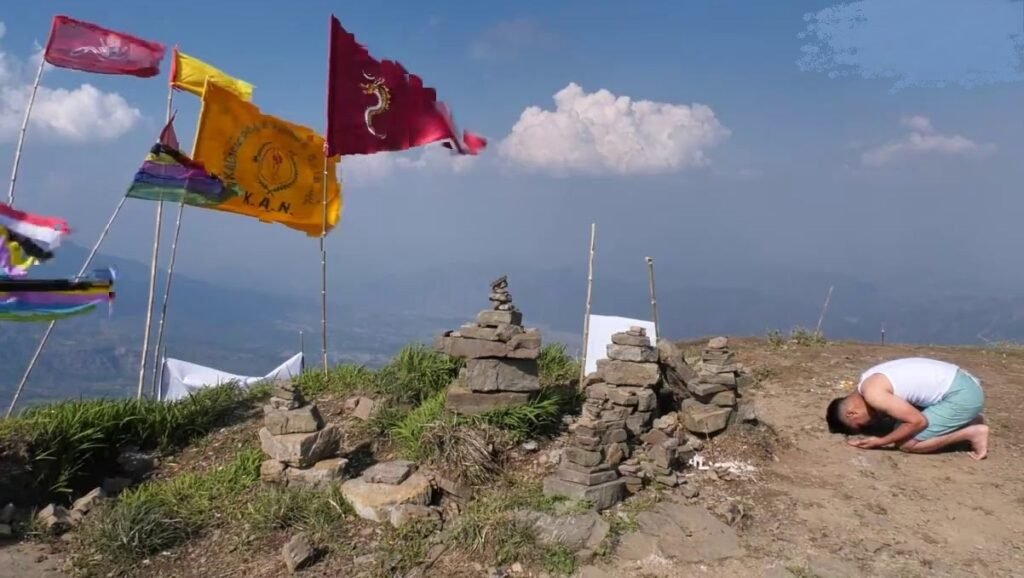The involvement of political leaders and CSO in claiming Koubru hills and Thangjing hills as “ancestral lands” of the Kuki is not in good taste. This is like inviting something, an unfathomable repercussions in the days to come. On several occasions, the State government’s sincere effort to revive the denuded encroached reserve forest in Koubru and Thangjing hills have been openly challenged by some Kuki CSO and political leaders. Illegally occupying religious sites of the indigenous people is a crime.
It is unfortunate that recently Saikot AC MLA, Paolienlal Haokip intervenes to a show cause notice issued by Forest Department for encroaching reserve forest areas of Manipur. Then followed by Kuki student organisations and other civil societies which prevents plantation drive by Forest officials in Thangjing hill range.
Last year, the Rongmei Naga Council, Manipur (RNCM), Inpui Naga Union, Manipur (INUM) and Zeme Naga Council, Manipur (ZNCM) have appealed to the Kuki civil society organisations to give up the claim on the Koubru range and all the lands belonging to the indigenous communities as their ancestral land. Mount Koubru is the religious sites of Lord Koubru who is the ancient god of the indigenous communities particularly the Meeteis, Kabuis, Koirengs, Rongmeis, Liangmais, Inpuis, Thangals, Zemes since time immemorial.
It is a common practice in Manipur that the non indigenous people are occupying religious sites like Thangjing and Koubru anc claiming as the owner of the place. They have been making false propaganda of preventing the ancestral lands of the forefathers. However, they have failed to understand that their forefathers were illegally occupying religious sites which existed much before they have arrived in Manipur.
It is noteworthy to understand that 966 unrecognised villages are either illegally encroaching the reserved forest or state lands. Out of which, 304 villages are in kangpokpi district alone. As per 1969 Gazette,there were only 179 recognised villages in Kangpokpi area. However, present number of villages is increased to 570.
In Churachandpur district, there were 282 recognised villages, now it increases to 547 villages. Unrecognised village figure is 281.
In Tengnoupal district, there were 68 recognised villages, now it rose to 168 villages. Unrecognised village found in this district is 130.
Similarly, in Chandel and Pherzawl district, we have now 130 and 14 unrecognised villages respectively. Number of villages in Pherzawl as per 1969 Gazette was only 38, now we the district have 70 villages.
How come all these new recognised and unrecognised villages occurred in the Kuki dominated districts only? While there is no significant increase of villages in Naga dominated and Meetei areas of Manipur.
The huge increased of unrecognised villages in these districts clearly indicates that most of them are refugees who came from Myanmar and other States bordering Manipur. Ironically, large scale deforestation and poppy plantations are also carried out in these unrecognised village areas.
“Awang koubru asuppa, leima lai khunda ahanba, nongthrei mayu lingliba, irik mapan thariba O Lainingthou,” tells us that north Koubru is the first habitation of Lai people. And Lainingthou Sanamahi which is the creator of all living beings is the king of gods.
On the top of Koubru peak, the Lai people have sown the seed for Meetei civilisation. The Lai people whom we consider as the forefathers of indigenous tribe descended from Koubru and settled in Imphal, some 20,000 years ago. Konjil Tukthaba Ibudhou Pakhangba was the first Monarch who came down from Koubru and settled in Imphal valley. Some went far ahead to Ukhrul side to settle in Kangkhui caves and some even went further down the south to settle in Thanlon caves. The archaeological findings have shown human settlements in these caves.
We can summed up that indigenous tribes having seven yek salai (clans) are the offspring of Lai people. Konjin Tukhthaba Ibudhou Pakhangba is the first king of Lai people (Meetei) who came down from Mount Koubru. Besides, we have four deities defending our lands. Ibudhou Marjing stays in the North East, Ibudhou Koubru in the North West, Ibudhou Thangjing in the South East and Ibudhou Wangbren in the South west of Manipur.
Meetei civilization is one of the oldest in the human evolution. Oral history is the living proof that the Meetei gods and goddesses stays in the hills of Manipur. These are properly documented in ancient puyas (records) and holy scriptures.
Mount Koubru is regarded as the cradle of Human civilization. It is the holiest place for Meetei, Kabui, Koireng and other original settlers of Manipur. This is like the Temple Mount of Jews, Ayodhya of Hindus and Mecca of Muslim.
Meetei believes that the departed souls have to face Heavenly deity Chingu Lai Pangganba which put questions standing by the heavenly gate – Oh! Human beings, did you visit the sacred sites of Koubru, Marjing, Nongpok Ningthou, Wangbren, Thangjing, Loyalakpa, Waroiching etc.
If our religious and ancestral lands are illegally occupied by refugees and prevent us from entering, then it would be termed as infringement to the Constitutional rights of Meetei and other indigenous people of the State.

